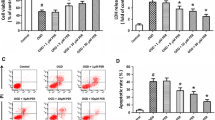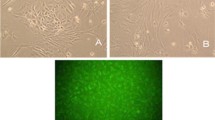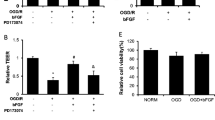Abstract
The destruction of the blood-brain barrier (BBB) contributes to a spectrum of neurological diseases such as stroke, and the hyperpermeability of endothelial cells is one of the characters of stroke, which is possibly exacerbated after reperfusion. However, the underlying mechanisms involving hyperpermeability after reperfusion between the endothelial cells remain poorly understood. Therefore, in the present study, the human microvascular endothelial cells (HBMECs) were exposed to oxygen-glucose deprivation/reperfusion (OGD/R) to mimic ischemic stroke condition in vitro with the aim to investigate the potential mechanisms induced by OGD/R. The permeability of cultured HBMECs was measured using FITC-labeled dextran in a Transwell system and transendothelial electrical resistance (TEER), while the RhoA activity was detected by pull-down assay. In addition, the phosphorylation of MYPT1, which reflects the activation of ROCK and the internalization of VE-cadherin, was detected by Western blot. It showed that OGD/R treatment significantly increased the permeability of HBMEC monolayers and facilitated the internalization of VE-cadherin in HBMEC monolayers. Pull-down assay showed that RhoA activation was obviously enhanced after OGD/R treatment, while RhoA and ROCK inhibitor significantly reversed OGD/R-induced HBMEC monolayers hyperpermeability and the internalization of VE-cadherin. Meanwhile, the knockdown assay showed that RhoA small interfering RNA (siRNA) led to similar effects. The inactivation of the downstream effector protein ROCK was also examined. Intriguingly, ROCK2 rather than ROCK1 exerted its adverse effects on HBMEC monolayer integrity, since ROCK2 knockdown markedly reverses the injury of OGD/R in HBMEC monolayers. In conclusion, the present study provides evidence that OGD/R may induce HBMEC monolayer hyperpermeability via RhoA/ROCK2-mediated VE-cadherin internalization, which may provide an impetus for the development of therapeutics targeting BBB damage in ischemic stroke.







Similar content being viewed by others
References
Asaithambi G, Tong X, George MG, Tsai AW, Peacock JM, Luepker RV, Lakshminarayan K (2014) Acute stroke reperfusion therapy trends in the expanded treatment window era. J Stroke Cerebrovasc Dis 23:2316–2321
Aslam M, Schluter KD, Rohrbach S, Rafiq A, Nazli S, Piper HM, Noll T, Schulz R, Gündüz D (2013) Hypoxia-reoxygenation-induced endothelial barrier failure: role of RhoA, Rac1 and myosin light chain kinase. J Physiol 591:461–473
Benn A, Bredow C, Casanova I, Vukičević S, Knaus P (2016) VE-cadherin facilitates BMP-induced endothelial cell permeability and signaling. J Cell Sci 129:206–218
Brailoiu E, Barlow CL, Ramirez SH, Abood ME, Brailoiu GC (2018) Effects of platelet-activating factor on brain microvascular endothelial cells. Neuroscience 377:105–113
Edwards D, Bix GJ (2019) Roles of blood-brain barrier integrins and extracellular matrix in stroke. Am J Physiol Cell Physiol 316:252–263
Gavard J (2014) Endothelial permeability and VE-cadherin: a wacky comradeship. Cell Adhes Migr 8:158–164
Harris ES, Nelson WJ (2010) VE-cadherin: at the front, center, and sides of endothelial cell organization and function. Curr Opin Cell Biol 22:651–658
Heasman SJ, Ridley AJ (2008) Mammalian Rho GTPases: new insights into their functions from in vivo studies. Nat Rev Mol Cell Biol 9:690–701
Heye AK, Culling RD, Valdés HMC, Thrippleton MJ, Wardlaw JM (2014) Assessment of blood-brain barrier disruption using dynamic contrast-enhanced MRI. A systematic review. Neuroimage Clin 6:262–274
Huang Y, Tan Q, Chen R, Cao B, Li W (2015) Sevoflurane prevents lipopolysaccharide-induced barrier dysfunction in human lung microvascular endothelial cells: Rho-mediated alterations of VE-cadherin. Biochem Biophys Res Commun 468:119–124
Jin R, Yang G, Li G (2010) Molecular insights and therapeutic targets for blood-brain barrier disruption in ischemic stroke: critical role of matrix metalloproteinases and tissue-type plasminogen activator. Neurobiol Dis 38:376–385
Kassner A, Merali Z (2015) Assessment of blood-brain barrier disruption in stroke. Stroke 46:3310–3315
Khatri R, McKinney AM, Swenson B, Janardhan V (2012) Blood-brain barrier, reperfusion injury, and hemorrhagic transformation in acute ischemic stroke. Neurology 79:52–57
Li R, Ren M, Chen N, Luo M, Zhang Z, Wu J (2012) Vitronectin increases vascular permeability by promoting VE-cadherin internalization at cell junctions. PLoS One 7:e37195
Li W, Chen Z, Chin I, Chen Z, Dai H (2018) The role of VE-cadherin in blood-brain barrier integrity under central nervous system pathological conditions. Curr Neuropharmacol 16:1375–1384
Luo SY, Chen S, Qin YD, Chen ZW (2016) Urotensin-II receptor antagonist SB-710411 protects rat heart against ischemia-reperfusion injury via RhoA/ROCK pathway. PLoS One 11:e0146094
Mark KS, Davis TP (2002) Cerebral microvascular changes in permeability and tight junctions induced by hypoxia-reoxygenation. Am J Physiol Heart Circ Physiol 282:1485–1494
MCA P, van Bezu JSM, van Nieuw Amerongen GP, van Hinsbergh VWM, Hordijk PL (2017) RhoA, RhoB and RhoC differentially regulate endothelial barrier function. Small GTPases:1–19
Nakamura M, Nagano T, Chikama T, Nishida T (2001) Role of the small GTP-binding protein rho in epithelial cell migration in the rabbit cornea. Invest Ophthalmol Vis Sci 42:941–947
Prakash R, Carmichael ST (2015) Blood-brain barrier breakdown and neovascularization processes after stroke and traumatic brain injury. Curr Opin Neurol 28:556–564
Rikitake Y, Kim HH, Huang Z, Seto M, Yano K, Asano T, Moskowitz MA, Liao JK (2005) Inhibition of Rho kinase (ROCK) leads to increased cerebral blood flow and stroke protection. Stroke 36:2251–2257
Semina EV, Rubina KA, Sysoeva VY, Rutkevich PN, Kashirina NM, Tkachuk VA (2014) Novel mechanism regulating endothelial permeability via T-cadherin-dependent VE-cadherin phosphorylation and clathrin-mediated endocytosis. Mol Cell Biochem 387:39–53
Shi Y, Jiang X, Zhang L, Pu H, Hu X, Zhang W, Cai W, Gao Y, Leak RK, Keep RF, Bennett MV, Chen J (2017) Endothelium-targeted overexpression of heat shock protein 27 ameliorates blood-brain barrier disruption after ischemic brain injury. Proc Natl Acad Sci U S A 114:1243–1252
Soeki T, Tamura Y, Shinohara H, Sakabe K, Onose Y, Fukuda N (2004) Elevated concentration of soluble vascular endothelial cadherin is associated with coronary atherosclerosis. Circ J 68:1–5
Stamatovic SM, Johnson AM, Keep RF, Andjelkovic AV (2016) Junctional proteins of the blood-brain barrier: new insights into function and dysfunction. Tissue Barriers 4:e1154641
Taddei A, Giampietro C, Conti A, Orsenigo F, Breviario F, Pirazzoli V, Potente M, Daly C, Dimmeler S, Dejana E (2008) Endothelial adherens junctions control tight junctions by VE-cadherin-mediated upregulation of claudin-5. Nat Cell Biol 10:923–934
Vandenbroucke E, Mehta D, Minshall R, Malik AB (2008) Regulation of endothelial junctional permeability. Ann N Y Acad Sci 1123:134–145
Wu L, Ye Z, Pan Y, Li X, Fu X, Zhang B, Li Y, Lin W, Li X, Gao Q (2018) Vascular endothelial growth factor aggravates cerebral ischemia and reperfusion-induced blood-brain-barrier disruption through regulating LOC102640519/HOXC13/ZO-1 signaling. Exp Cell Res 369:275–283
Xiang J, Routhe LJ, Wilkinson DA, Hua Y, Moos T, Xi G, Keep RF (2017) The choroid plexus as a site of damage in hemorrhagic and ischemic stroke and its role in responding to injury. Fluids Barriers CNS 14:8
Xiao K, Allison DF, Buckley KM, Kottke MD, Vincent PA, Faundez V, Kowalczyk AP (2003) Cellular levels of p120 catenin function as a set point for cadherin expression levels in microvascular endothelial cells. J Cell Biol 163:535–545
Ysrayl BB, Balasubramaniam M, Albert I, Villalta F, Pandhare J, Dash C (2019) A novel role of prolidase in cocaine-mediated breach in the barrier of brain microvascular endothelial cells. Sci Rep 9:2567
Acknowledgments
We thank Professor Gui bo (Department of Anesthesiology, 1st Affiliated Hospital of Nanjing Medical University, China) for his selfless help in the research process.
Funding
This work was supported by the National Natural Science Foundation of China (81701872) and by a grant from the Nanjing Medical University Science and Technology Development Fund Project (2015NJMUZD010).
Author information
Authors and Affiliations
Corresponding authors
Ethics declarations
Conflict of Interest
The authors declare that they have no conflict of interest.
Additional information
Publisher’s Note
Springer Nature remains neutral with regard to jurisdictional claims in published maps and institutional affiliations.
Rights and permissions
About this article
Cite this article
Chen, J., Sun, L., Ding, Gb. et al. Oxygen-Glucose Deprivation/Reoxygenation Induces Human Brain Microvascular Endothelial Cell Hyperpermeability Via VE-Cadherin Internalization: Roles of RhoA/ROCK2. J Mol Neurosci 69, 49–59 (2019). https://doi.org/10.1007/s12031-019-01326-8
Received:
Accepted:
Published:
Issue Date:
DOI: https://doi.org/10.1007/s12031-019-01326-8




